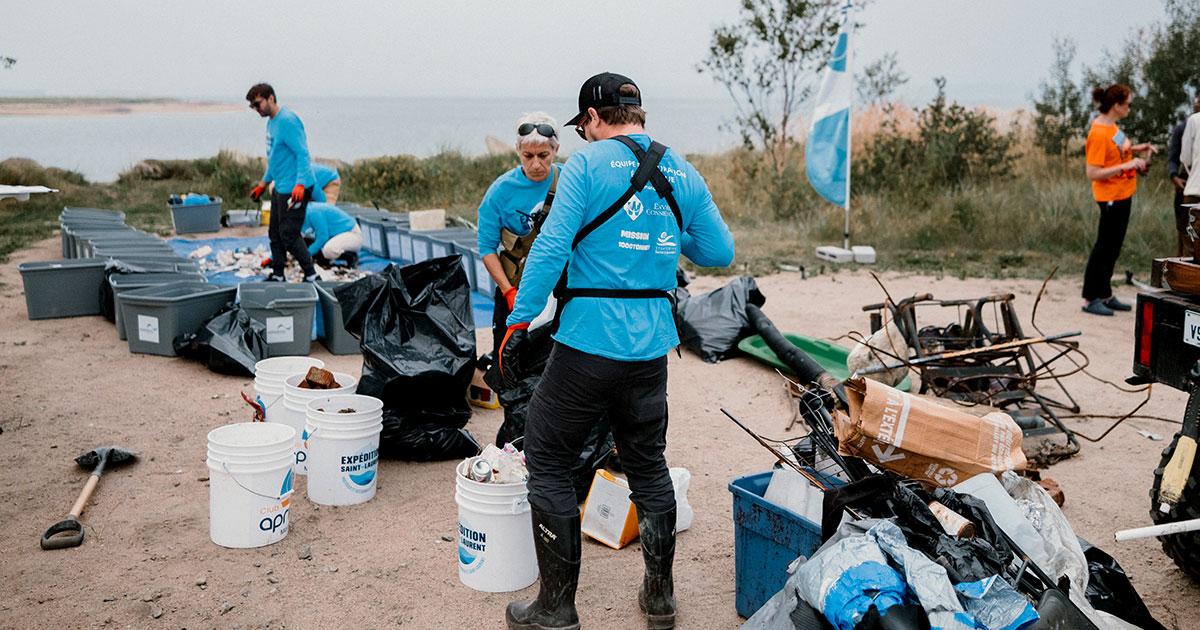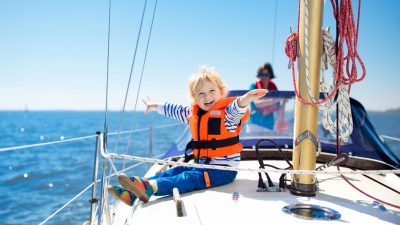
Jimmy Vigneux (Mission 1000 tonnes mission leader and managing director of Stratégies Saint-Laurent) & Safouane Khamassi (Scientific Program Manager Stratégies Saint-Laurent)
Every year, tonnes of waste are discharged into the environment. Even when discarded at a distance from watercourses, this waste is carried away by run-off water during rainfall and snowmelt. It ends up in the oceans, polluting marine ecosystems. In Quebec, the St. Lawrence River is particularly hard hit by this phenomenon, receiving waste from all over the province and mixing with ocean currents.
During its journey and once in the water, waste degrades, transforms and pollutes the ecosystem, impacting fauna, flora and humans alike. For example, the fragmentation of plastics, under the effect of UV rays, waves and temperature changes, releases thousands of microplastics, invisible to the naked eye, into the environment. The problem doesn’t stop there. Microplastics have an exceptional capacity to adsorb pollutants from water, such as pesticides, heavy metals and industrial chemicals. By acting like real sponges, they concentrate these harmful substances, making them much more toxic for living organisms.
The consequences are multiple and disastrous for biodiversity. From the smallest organisms to the largest marine mammals, microplastics are ingested with food, leading to intestinal blockages, malnutrition and poisoning from adsorbed pollutants. Microplastics and associated pollutants accumulate in the food chain, passing from one organism to another. Certain chemicals in plastics can disrupt the endocrine systems of living organisms, leading to developmental abnormalities, reproductive problems and increased susceptibility to disease.
The Saint-Laurent Expedition
“The Club APRIL Marine, committed to the health of our waterways, has been a key partner of Saint-Laurent Expedition 2024.” Says Jimmy Vigneux, Mission 1000 Tonnes Mission Leader. In collaboration with Mission 1000 Tonnes and Stratégies Saint-Laurent, more than 12 Quebec towns and cities, from Montreal to Anticosti Island, mobilized to clean up the riverbanks.
Thanks to this initiative, over 8 tonnes of waste were removed directly from the banks of the St. Lawrence. Rigorous characterization work identified the main pollutants, providing a better understanding of the sources of contamination. Over 31,000 items of waste were sorted and weighed, providing invaluable data to guide future actions and encourage changes in behavior.
Single-use plastics: the big winners of the Expedition
The categories of waste most commonly observed on the banks of the St. Lawrence include various sources of single-use plastics. Hard plastic pieces, plastic film and Styrofoam alone account for more than 10,000 pieces of waste, making up the top category in terms of numbers. Second place went to cigarette butts, of which Expedition St. Lawrence volunteers collected over 5,500. Third and fourth place went to fast-food waste (4,500 pieces) and food packaging (3,000 pieces). These categories include plastic bottles and caps, cans, plastic cups, glasses and straws, and chip, cookie and candy wrappers.
These types of waste are prevalent in absolutely every location Expedition St. Lawrence has visited. Other recurrent categories observed in a significant way include paper receipts, plastic bags and various pieces of scrap metal, wood and tires. Due to their density, the latter types of waste, which fall into the categories of construction materials and mechanical parts, make up two-thirds of the total weight of waste collected.
It was interesting to note notable differences in the waste observed according to region. For example, as you go further east in Quebec, you come across more objects from hunting and fishing. Volunteers collected over 700 shotgun shells, and 400 pieces of rope, nets, lines, buoys, bait pots and lobster elastics. Once again, most of these items are made of plastic.
Waste travels
What’s striking is the omnipresence of waste, even in the most unexpected and remote places. Of course, big cities like Montreal produce more plastic waste than small villages on the North Shore, but waste travels with the currents of the St. Lawrence. This partly explains why over 3 tonnes of waste were removed from Anticosti Island, which has a permanent population of less than 500. For example, during the St. Lawrence Expedition, coffee glasses from a well-known fast-food chain were found on the island’s beaches, even though the chain has no branches on the island. It was the currents that carried this waste to the shores of Anticosti, just like the numerous items of fishing waste found in the St. Lawrence Estuary.
The accumulation of garbage on riverbanks not only harms the environment, but also the beauty of our landscapes. To effectively combat this scourge, it is essential to reduce our waste production and adopt more responsible waste management practices. Each and every one of us can contribute to this approach by adopting simple everyday gestures, such as sorting and recycling our waste and picking up any garbage we come across on a daily basis, even if it isn’t our own.


